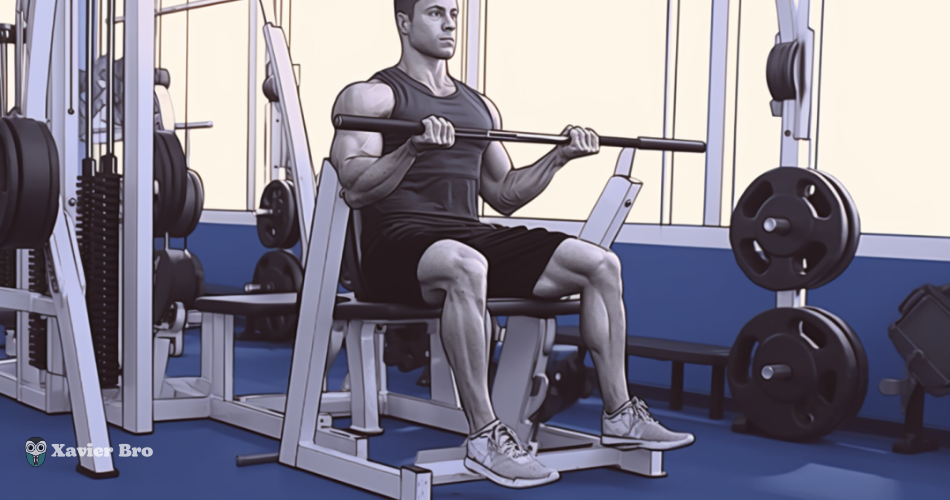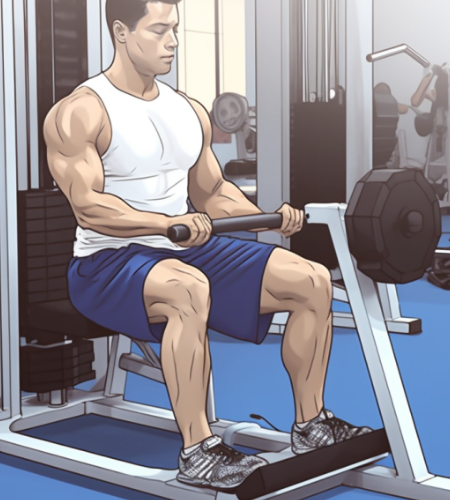The calf raise machine, also known as the Hack Squat Machine, is an essential piece of equipment for any gym. It’s a versatile exercise machine used to target and strengthen the muscles in your calves.
The calf raise machine can be used by both beginners and experienced lifters, giving every user a chance to get a great workout with the proper form and technique. This guide provides an overview of how to use the calf-raise machine effectively and safely.
What is a Seated Calf Raise?
A seated calf raise is an exercise performed using the calf raise machine. It involves sitting on the machine and pushing your toes against the weighted platform while keeping your ankles extended and contracted. This exercise targets the calf muscles in your lower legs, providing you with strength and definition.
How to Use a Calf Raise Machine: Step-by-Step Guide
Let’s learn the steps for using a calf raise machine:
Step 1: Adjusting the Machine
The first step to using the calf raise machine is properly adjusting it for your body. To do this:
- Locate and loosen the set screws on either side of the lever arm pad.
- Slide the pads to adjust them closer or further away from you as necessary so that they fit comfortably against your lower legs.
- Securely tighten the screws once the pads are adjusted to your desired position.
Step 2: Positioning Your Body
Once the machine is properly adjusted, it’s time to get into position. Stand facing the calf raise machine with your feet shoulder-width apart and place your lower legs beneath the lever arm pads. Hold onto the machine’s handles for support as you slowly lower your heels until they are just above the floor.
Step 3: Performing the Exercise
Now comes the actual exercise. From the lowered position, press up through your toes and raise your heels until you stand on tiptoes. Hold for a few seconds before returning to the starting position. Make sure to keep your core engaged throughout the entire motion.
Step 4: Finishing Up
Once you have completed the set, slowly lower your heels to the floor and release your grip from the machine’s handles. Take a few moments to rest before performing another set if desired. These steps ensure you get the most out of your calf raise machine workout.
Benefits of Calf Raise Machine
The calf raises Machine is a great way to target and strengthen the muscles in your lower legs. With regular use, you’ll reap the following benefits:
1. Improved Balance
Working out on a calf raise machine can help improve balance, as it forces you to use both legs together for stability.

2. Stronger Calves
The calf raises machine is an effective exercise for strengthening your calves. Increasing strength in this area can help improve performance in sports and activities and reduce the risk of injury.
3. Improved Circulation
Working out on a calf raise machine improves circulation throughout your body. This is beneficial for overall health since it helps reduce the risk of various conditions.
4. Increased Flexibility
People who use the calf raise machine regularly will see increased flexibility, as this exercise works on dynamic and static flexibility. This can help enhance performance in sports and everyday life activities. It also gives support to your fingers and hands; you can also lose weight in your fingers using a calf raise machine.
What Muscles Does Seated Calf Raise Work?
Seated calf raises primarily target the gastrocnemius and soleus muscles in your calves. Here is the list of other secondary muscles that are also activated during the exercise:
1. Tibialis anterior
The tibialis anterior is a muscle in the front of your lower leg. It helps raise your feet and toes, which can help with balance when standing and walking.
Calf raises allow you to exercise this Muscle without having to stand up by placing the ball of your foot onto the platform and pushing through your heels. This exercise can also help strengthen your ankle and foot muscles, improving balance.
2. Peroneals
The peroneals are a group of muscles located outside your lower leg. They help stabilize and move your ankle and foot when standing and walking. Seated calf raises can help activate these muscles as you push through your heels, helping them become stronger to improve balance and stability.
3. Hamstrings, Quadriceps and Gluteus
The hamstrings, quadriceps, and glutes are muscles located in the upper leg. As you push through your heels while doing seated calf raises, these muscles will also be activated to help stabilize your lower legs as they move. This helps build strength and endurance in the upper leg muscles and improves balance and stability.
4. Gastrocnemius
The gastrocnemius muscle is one of the main calf muscles. It helps to bend your knee and flex your ankle. You will activate this Muscle when doing seated calf raises as you push through your heels with resistance. This can help increase strength and size in the gastrocnemius while also improving balance and stability.
Common Mistakes and Errors
Let’s explore some common mistakes and errors in using a calf-raise machine:
1. Not Positioning the Feet Correctly
One of the most common mistakes people make when using a calf raise machine is not positioning their feet correctly. Make sure your feet are firmly planted on the footplate and not too close to the edge, as this will reduce stability.
Additionally, it’s important to maintain good posture throughout the exercise and not allow your torso to lean forward or backward.
2. Going Too Fast
Another common mistake is doing the exercises too quickly, reducing stability and increasing the risk of injury. Always keep a steady pace throughout each repetition, as this will help you maintain good form and get better results from your workout.
3. Not Keeping the Movement Controlled
When using a calf raise machine, it’s important to control the movement during both the up and down motion. Don’t just drop back into the starting position, as this can reduce your range of motion and result in poor form.
4. Not Doing Proper Warm-Ups
Before beginning any exercise routine, make sure to warm up your muscles properly. This will help reduce the risk of injury and make the exercise more enjoyable.
Rep Schemes and Benefits
When using the calf raise machine, it’s important to understand that different rep schemes will target different areas of the calves. For instance, doing higher reps with lighter weights will emphasize muscular endurance, while doing lower reps with heavier weights will build strength and size.
Regardless of which rep scheme you choose, you can expect benefits such as improved balance, enhanced athleticism, and increased calf strength and size.
Form and Technique
Proper form and technique are essential to getting the most out of your calf raise workout. When positioning yourself on the machine, ensure your feet are securely placed in the stirrups for support. It’s also important to keep your back straight, your chest up, and your head in a neutral position.
When performing the movement, it’s important to focus on using a full range of motion for maximum effectiveness. This means going all the way down until your calves are as low as they can and then pushing back up until they are fully contracted.
Wrapping it Up!
The calf raises machine is a great tool for anyone looking to build strength and size in their calves and improve balance and athleticism. Always use proper form and technique when performing the exercise, focus on different rep schemes to target different areas of the calves, and maintain a full range of motion for maximum effectiveness. With the right approach and dedication, you’ll be able to get great results from your calf-raise machine workouts.
How to Use a Calf Raise Machine FAQs
The number of calf raises you should do daily will depend on your fitness level and goals. Generally, it is recommended to start with 3 sets of 10-15 repetitions and gradually increase the number as you become stronger.
The best way to perform a calf raise is by standing with your feet hip-width apart, slowly raising up onto your toes, and then lowering yourself back down again. Keep your knees slightly bent during the exercise, and use a wall or railing for support if needed.
Yes, it is generally safe to do calf raises every day as long as you are not overworking your muscles or putting too much strain on them. As with any exercise, start slowly and gradually increase the repetitions and intensity.
The calf can help you build muscle in your lower legs if done correctly and consistently over time. Make sure to gradually increase the weight and repetitions as your muscles become stronger, and you will see results over time.
Although calf raises are generally considered safe to do, there is a potential risk of injuring your Achilles tendon if you try to lift too much weight too quickly. Listen to your body and start slowly with this exercise to avoid injury.
I hope so you enjoy our article, do check out more of our amazing articles.
